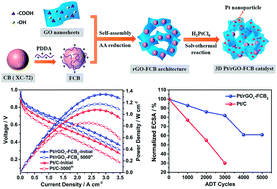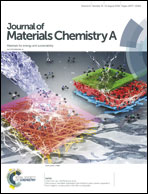Anchoring ultrafine Pt nanoparticles on the 3D hierarchical self-assembly of graphene/functionalized carbon black as a highly efficient oxygen reduction catalyst for PEMFCs†
Abstract
3D graphene-based nanostructures have been recently considered to be promising supports in the fuel cell field. However, the problems of complexity and high cost in their preparation process limit their practical applications. Herein, we developed a facile and cost-effective approach to fabricate a novel 3D hierarchical architecture constructed from reduced graphene oxide (rGO) and poly(diallyldimethylammoniumchloride) functionalized carbon black (FCB) to anchor Pt NPs as an efficient electrocatalyst for proton exchange membrane fuel cells (PEMFCs). By optimizing the weight ratio of rGO/FCB, we find that the Pt/rGO1−FCB2 possesses a well-defined 3D interconnecting framework with large surface area, desirable porosity, high graphitic crystallinity and homogeneous dispersion of ultra-fine Pt nanoparticles. Benefiting from the unique structural features, the Pt/rGO1–FCB2 catalyst exhibits notably improved activity and remarkable stability for the oxygen reduction reaction (ORR) compared to commercial Pt/C. Moreover, an electrode prepared with this architecture demonstrates superior performance in single cell testing, with a peak power density of 1.344 W cm−2 and a maximum mass specific power density of 7.5 W mgPt−1, which are 1.25-fold greater than those of the conventional Pt/C electrode. Additionally, the variation of the electrochemically active surface area, power density and the kinetic resistance during the accelerated degradation process implies that the Pt/rGO1–FCB2 electrode possesses much enhanced electrochemical durability compared to Pt/C. The research results indicate that the 3D Pt/rGO–FCB will be a promising candidate for next generation of cathode electrocatalysts in PEMFCs.



 Please wait while we load your content...
Please wait while we load your content...